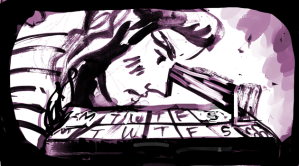Annie Cohen-Solal feels a deep kinship with the artist Mark Rothko, the subject of her excellent new biography, Mark Rothko: Toward the Light in the Chapel. An academic and a cultural historian, Cohen-Solal is also the author of award-winning books on Jean-Paul Sartre and the influential New York City art dealer Leo Castelli. In a recent interview with the Jewish Advocate, Cohen-Solal, who lives and works in her native France, explained the impetus for writing about Rothko for Yale University Press’ series on Jewish Lives. “ Like Rothko I am between nations and cultures and I too am a cosmopolitan Jew.”
Mark Rothko was born in Dvinsk, Russia, now Latvia, in 1903. His father Yacov Rotkovitch, a pharmacist, was a bookish secular Jew. His mother Kate came from a privileged Jewish family in Saint Petersburg that was barely touched by anti-Semitism. The marriage was a social coup for Yacov who brought his bride back to Dvinsk where the couple had four children. Mark, the youngest, was the only child to attend cheder. Cohen-Solal explains that Rothko’s “education in Talmud Torah did not align with his family’s secularism. He was fourteen years younger than his oldest brother and at the time there was this threat of thrusting Jewish boys into the Russian army. He went to Talmud Torah to avoid getting drafted.”
Alarmed by encroaching pogroms, the elder Rotkovitch immigrated with his two older sons to America in 1908. Two years later, Kate followed with her daughter and her youngest son. The family settled in Portland, Oregon where they had relatives. They lived among other Russian Jews in a neighborhood nicknamed “Little Odessa.” Three years after the family was reunited in Portland, Yacov died. Cohen-Solal points out that the family was so secular that ten year-old Mark, who had the most Jewish education among them, was the only relative who said the Mourner’s Kaddish for his father.
Marcus Rothkowitz, as he was known in Portland, excelled in high school and earned admission to Yale University along with two of his Jewish classmates. When Marcus arrived in New Haven in 1921, the campus was a WASP bastion of privilege and anti-Semitism. “He was disillusioned and disappointed,” Cohen-Solal said. “He didn’t agree with the policies of the closed fraternities. He was a rebel at heart and created a newspaper called the Yale Saturday Evening Pest, which destroyed the values of the institution rather than complying with them.” She further delineates the classist rivalry between Yale’s German and Russian Jews. Having immigrated earlier to the United States and succeeded socioeconomically, German Jews had an easier time fitting into Yale life.
After his scholarship was revoked in his sophomore year, Marcus left Yale and went to New York. Legend has it that his art career was launched after he visited a friend studying figure drawing at The Art Students’ League. “At the age of 20 Marcus was already a role model,” says Cohen-Solal, “He was an intellectual, a fighter, an educator. He was an individual who confronted the injustice of American society, the narrow-mindedness he encountered at Yale all the way through the Metropolitan Museum of Art. Art was a form of social action for him.” Young Marcus’ career took off when the American artist Milton Avery mentored him. “Avery was [Marcus’] American role model and a father figure to him.”
The 1920s was also a time when Rothko negotiated his internal tensions between Europe and the United States, the West Coast and East Coast, as well as his Jewish and secular influences. In his artwork from 1928 and 1939, Rothko moved towards his signature style by first painting landscapes, watercolors and oil paintings with enigmatic, phantom-like figures. Come the late 1930s Marcus Rothkowitz became an American citizen and changed his name to Mark Rothko.
Cohen-Solal notes that by the 1940s, “there was so much in Rothko’s work as a painter that could be described and integrated by his Judaism. Like many Jewish artists at the time, he thrived in the abstract, which may have been influenced by the Second Commandment about not making ‘graven images.’”
As for Rothko, many of his Jewish values came together in the paintings he did for the Rothko Chapel in Houston, Texas. Commissioned by Jean and Dominique de Menil, the chapel is an ecumenical space dedicated to peace. As Cohen-Solal notes, three immigrants, one fleeing pogroms in Russia and two escaping Nazi-occupied France, created a meditative space that was as much political as it was spiritual.
“What Rothko has done with his art is to talk to the 21st century,” says Cohen-Solal. “Think of the terrorist attacks in which art has been destroyed. An immigrant carries tools that he can turn into destruction or creativity. Rothko’s life is not only a model for immigrants today, he demonstrates that the history of art is the history of hunger over compliance.”
This article originally appeared in the March 20, 2015 issue of the Jewish Advocate


